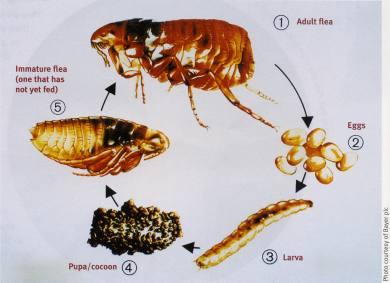
FLEA CONTROL
My dog always seems to have fleas. What can I do?
Successful flea control involves:
1. Eliminating fleas from your dog
2. Controlling fleas in the environment
Dogs and cats share the same fleas. It is important that all pets in your home are on a flea preventive. Treating your pet for fleas has never been easier. With the many choices we have today, we can provide you with the safest and most effective flea preventive for your pet’s needs.
When it comes to environmental control, we must first understand the flea life cycle.
There are four stages in the life cycle of the flea:
Flea eggs are whitish and about 0.5 millimeter (mm) (1/32”) in length. They are unlikely to be seen without a magnifying glass. Eggs are laid by the adult flea after taking a blood meal. The eggs are initially laid on the dog’s skin but fall off into the environment to continue their life cycle. Flea eggs constitute approximately 50% of the total flea population. Eggs may hatch in as little as 14 to 28 days, depending on environmental conditions. High humidity and temperature favor rapid hatching
Flea larvae are about 2-5 mm (1/8” to 1/4”) in length. They feed on organic debris found in their environment and on adult flea feces. They dislike bright light and move deep into carpet fibers or under furniture, organic debris, grass, branches, leaves and soil. Flea larvae prefer warm, dark and moist areas. Outdoor larval development occurs only in shaded, moist areas where flea infested pets spend a significant amount of time. Our climate-controlled homes offer an ideal environment for the flea larvae to thrive.
The flea pupae produce a protective silk-like cocoon which is sticky. It quickly becomes coated with grime and debris, which acts as a useful camouflage. With warmth and humidity, pupae become adult fleas in 5-10 days. The adults do not emerge from the cocoon unless stimulated by physical pressure, carbon dioxide or heat. This is important since once fleas emerge from the cocoon they can only exist for a few days unless they are able to feed. Pre-emergent adult fleas can survive within the cocoon for up to 9 months. During this time they are resistant to insecticides applied to the environment. This is important to remember because adult fleas may emerge into the environment a considerable time after you apply insecticides in your home.
Once it emerges, the flea adult, unlike the larvae, is attracted to light and heads to the surface in order to encounter a passing host to feed upon. Two days after the first blood meal, female fleas begin egg production. In normal circumstances the adult female will live up to three weeks, laying approximately 40 eggs per day. The entire life cycle, from egg to adult flea can be completed in 14-28 days depending on environmental conditions.
Apart from irritation, are fleas particularly harmful?
Fleas can cause anemia in heavy infestations, especially in young or debilitated dogs. A single female flea can take up to 15 times her body weight in blood over the several weeks of her adult life. In addition, fleas can carry several diseases, including plague, and also act as vectors to spread one of the most common tapeworms of the dog and cat, Diplylidium caninum.
How do I prevent fleas on my dog?
Successful flea control includes treating both the environment as well as your pet.
What shall I put on my dog?
Shampoos, sprays, powders and topical preparations are all available. Be sure to consult your veterinarian to choose the most effective and safe flea products for your home and pet.
What about the environment?
Environmental preparations are becoming increasingly sophisticated. Remember that most products are only effective against the adult flea. Your veterinarian can provide you with flea products that contain Insect Growth Regulators (IGR) that will help destroy the flea eggs and larvae. Before applying any environmental product, we recommend vacuuming your carpet to stimulate the pre-adult fleas to emerge from their protective cocoons. Be sure to discard the vacuum cleaner bag after its use.
My dog lives most of his life outside. What should I do?
Concentrate on dark, shaded areas. Spray a product containing an IGR and repeat every 14-21 days for three to five applications.
The newer topical and oral flea preventives will greatly assist you in solving your flea problem. With persistence and patience, you and your pet will be flea-free in no time!
This client information sheet is based on material written by Ernest Ward, DVM.
© Copyright 2005 Lifelearn Inc. Used with permission under license. September 12, 2017
